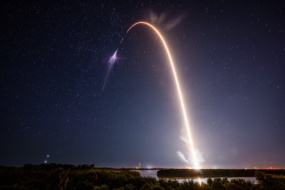With just two Starship integrated test flights under its belt, SpaceX announced last week it is already working on a major overhaul of its second-stage Starship vehicle. The design changes will be significant enough to speciate the ship, giving it the title of Version 2.
SpaceX plans to finish and launch four or five additional Starship V1 prototypes before transitioning to its V2 product line, Elon Musk said on X. Insights gained from the upcoming flights will be integrated into the next-gen rocket.
Solid showing: The Starship spacecraft performed well during the initial ascent of IFT-2, with all six Raptor engines lighting up and propelling the vehicle to an altitude of 150 km. However, at that point—just prior to the completion of its second stage burn—Starship’s telemetry was lost, and the self-destruct button was triggered.
Wen IFT-3? SpaceX engineers will review the flight, make slight tweaks, and attempt to reach near-orbit again with IFT-3, likely using Booster 10 and Starship 28. Musk said that the hardware would be ready for flight in 3-4 weeks. So, if we add the Elon multiplier, divide by pi, and factor in this month’s horoscopes, our bet is that an early 2024 Starship launch may be in the cards.
Starship V2
According to Musk, Starship V2 will increase propellant capacity, reduce dry mass, and improve overall reliability.
While exact V2 specs were not provided, SpaceX has recently outlined several Starship changes it may eventually incorporate.
- Raptor 3: Along with teasing a Starship V2 late last week, Musk also highlighted the development of its next-generation Raptor 3 engine—which he said would have a higher Isp than the Raptor 2, generate 20% more thrust, and be reliable enough not to require a heat shield. Eliminating engine shielding would significantly reduce mass.
- Six to nine engines: Starship V2 may be the first time we see nine Raptor engines on the vehicle, a change SpaceX has long wanted to make.
- Increase propellant volume: The company has explored increasing propellant volume by altering the shape of the fuel tanks and stretching Starship’s height by five to 10 meters.
Current production: SpaceX is building its Raptor engines at a rate of one engine a day, and full-stack Starship structures at an average rate of ~three per year.
Starfactory: To increase Starship production, SpaceX will soon open a massive Starfactory production facility at Starbase in Texas (yeah, enough with all these star-names). Starfactory will be an assembly-line style facility that SpaceX hopes will eventually be able to pump out 400-ft rockets at a rate of one per week. The facility will be responsible for mass-producing SpaceX’s new V2 Starships.




